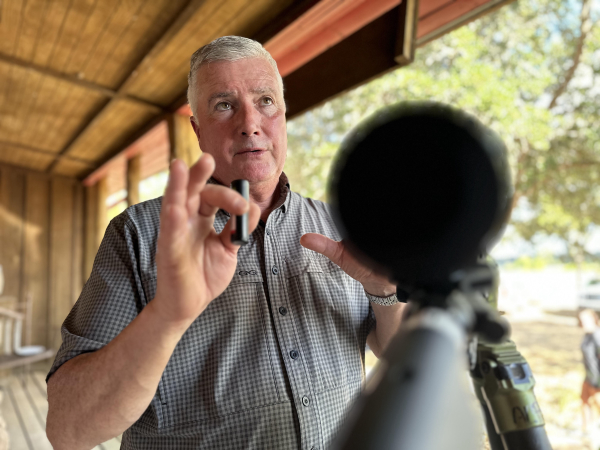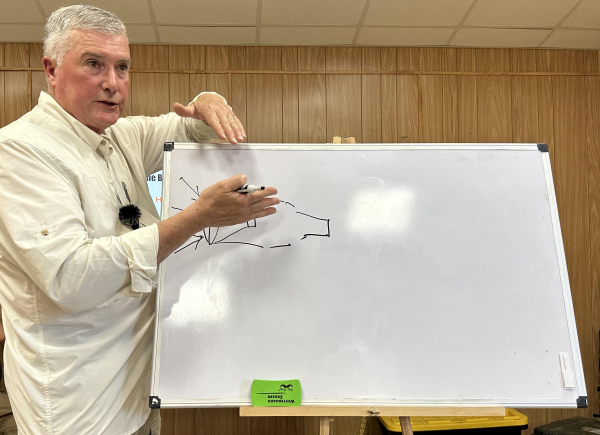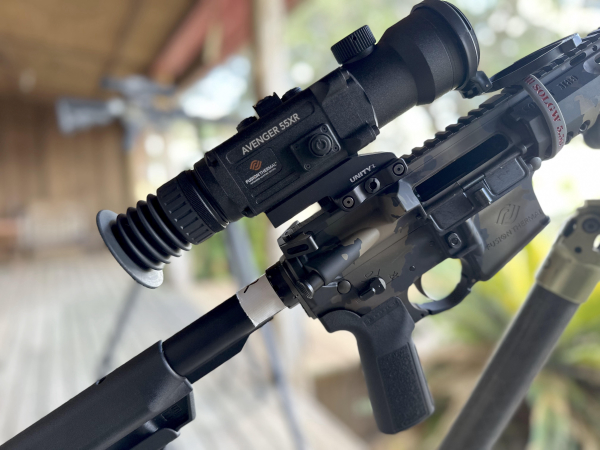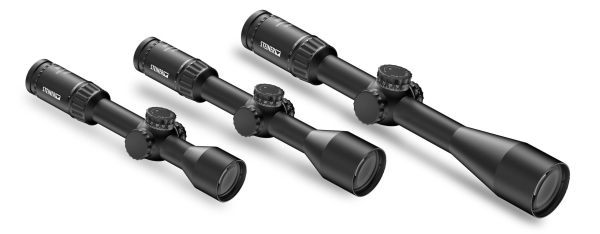Thermal vs Night Vision Explained

Q: What got you into the optics industry?
A: I got into the optics industry about 25 years ago after a friend lent me a pair of his Steiner 10x50mm military marine binoculars. I used it on a deer hunt, and it changed my life. It started a lifelong passion for optics and looking for perfection in optics as I’ve gone along in the last 25 years and just studied and learned and got into all the details that I could, and ultimately, here I am with our thermal brand, Fusion Thermal.
Q: Fusion Thermal is a new company. How did it start?
A: I had a supplier friend who started a company. He found a physicist in Europe who had a fascinating and unique spin on thermal technology, and they made a presentation to me primarily for me to be their customer. I liked seeing a lot of thermal experience and that he had something radically different. So I was intrigued, and I agreed to become their customer. Ultimately, six months later or so, I owned the company and, rebranded it Fusion Thermal and designed it to be more Americanized and more user-friendly.
Q: What advantages do thermal optics have over other night optic technologies like light-intensified optics or add-on lights?
A: Thermal is a new technology to many people; sometimes, they lump it into the same category as night vision. It’s night vision in the sense that you use it at night. But thermals can be used very effectively in the daytime. That’s one of its advantages over traditional night vision.
So traditional night vision is where you take environmental light, moonlight, or starlight and amplify it 30,40,50, 60,000 times and recreate an image. That’s a very different technology than thermal. It has an inherent advantage that you are like normal day vision and can see a lot of detailed imagery of what you’re looking at.
The first problem with night vision is that you can only use it at night. The second problem is it offers very poor detection. This is where thermal stands out. You can’t escape your body heat. An animal can’t escape its body heat. An animal could hide behind a bush or foliage with a traditional night vision optic. But with thermal, some heat energy will leak through that bush or vegetation, and they will stand out. So, the detection of thermal is its significant advantage. And its resolution continues to get better and better as technology advances. But the problem with thermal traditionally is that it’s been very expensive and priced, you know, $30, $40,000 for a high-end weapons site ten years ago. Well, now it’s much more affordable. And night vision traditionally is still in that $5 or $6,000 range for the good stuff. So thermal optics has turned the whole night-vision night-hunting industry on its head, and it is the way to go.
As far as add-on flashlights? The problem with adding flashlights or spotlights is that animals catch on to your location quickly when you do that. So thermal has all the advantages of keeping you stealthy and having unbelievable detection capabilities.
Q: What advice do you have for people interested in buying thermal optics?
A: So I often ask this question: What’s the best way to shop for a thermal? If I’m new to this and want to go out, I, three, four, or $5,000 is a lot of money. I don’t want to get burned.
How can I buy this in a smart way?
First, I will tell you to forget about reading website specs. They mean nothing.
If you shop by specifications alone, you will have something less desirable than anticipated. You can count on it. Please go to your dealer and compare the units. I’m not suggesting that you don’t look at people’s websites as a starting point. But don’t use that as your definitive decision. Because the specifications in a static environment mean nothing is the combination, the quality of those materials, and how they work together in a final design-build.
- Forget specifications.
- Go to your pro shop.
- Look through the device, do your homework, and call us. If you want to talk to somebody who knows thermals, contact us; we’ll walk you through every feature.
Q: What makes Fusion Thermal different?
A: There’s a guiding principle at Fusion Thermal in it’s that we build tools, not toys. One of the most interesting things about how people shop for optics is that they get on websites, read specifications, and look at things like the sensor pixel count and the refresh rate. What’s the screen resolution? The truth is there are so many components in a device like this that make it work well. It’s all come together, and let me give you a, for instance, if you go on everybody’s website, ours, our competitors, no industry standard judges the purity of the lens. And the lens is the most critical thing in a well-crafted thermal, the most expensive component of the entire device. And yet, this is where major concessions are made.
There is a dramatic difference in quality difference in lenses. And since you can’t see through these lenses as humans (thermal optics use Germanium, not “glass”), it’s hard to judge the quality of a small, like a day scope where you can look through it and see impurities. You can see the image defects, you can see cloudiness, you can see blurry spots; you can’t see that in a thermal device. So many manufacturers skimp here, and this is one of the areas we focus on with our Arclight Ultra HD lens, ground from the purest grade of Belgium germanium available. But that’s just one example of many different components.

Q: What’s new for Fusion Thermal?
A: So this is our flagship model, the Avenger 55XR. It’s a high-end 640 processor. It’s got an oversized 55-millimeter lens. Our light lens is a big key to the performance, dumping a lot of energy onto the face of the sensor. All of our Fusion Thermal products follow the same design philosophy. We have a much-simplified control panel. There’s no other thermal in the market that’s even close to being as simple to use as a fusion thermal product. And they’re all designed with the same feature sets to build on top of one another. But if you learn to use one of our devices, you can use any of them.
Q: What is one way Fusion Thermal simplified the thermal user experience, and why is it important?
A: So we have a three-button control system. We move the power button to the side to get it out of your way. You have no reason to stumble over the power button in the dark. We have the media button; this is the record button. This unit has full video photo and HD audio recording. You can push the button, turn on the recording, and turn it off as a 30-gig hard drive enough to record about 40 hours of video; just an incredible amount. It has Wi-Fi, so it can live stream to your phone. You can download images via the Wi-Fi or the USB cable feature.
Q: I understand Fusion Thermal optics focus differently than other thermals. How and why?
A: One of the most essential features our customers like is micro-click focus. Almost all of our competitors use what we call a collar focus. We find that that gets in the way of your operation in the field. So, for instance, if you’ve got the lens cover here or flipping up top where it’s commonly it’s in your way, by having a knob here, you have no problem operating this even with a gloved hand, and we put small fine details we call them micro clicks that allow the user to get exactly on time. It’s the perfect focus point every time.
Q. What other design elements are engineered into your optic?
A: One of the most important things about our design is we don’t do plastic housings. This housing is AL6068. It’s structural aluminum. There are obvious strength and durability reasons that come with it. But one of the significant considerations why we use these particular materials is to transfer heat energy from the device. Thermals generate a lot of heat, so many thermals don’t run as well 30 minutes after operating as they did when they first turned on because they internally heated up. Thermal performance degrades heat, but it also kills the electronics over time and degrades the useful life of the equipment. All of our products come with a five-year transferable warranty. And we make that bold warranty claim because of this housing device; we know how to get the heat out of the unit.

Q: What else can you tell me about your new Avenger 55XR?
A: This unit has high-end Tannenberg cylindrical covers on it. So you can pull these on or off. They’re just virtually indestructible. If you break it, of course, we have more that you can get it comes right off this feature. It uses 218 650 rechargeable batteries. We are not a fan of proprietary battery systems. Some of our competitors make proprietary batteries; they’re on their third and fourth-generation battery designs. You can’t even get batteries for their older units. We use the common 18650 battery. These are available everywhere. Amazon, Walgreens, Walmart, and they’re at every vape shop. This is what they use in vape equipment, and it’s got an incredible amount of power. Even with the 640 processor, this unit gives enough runtime to run about seven hours. Our 340 unit runs nine hours. So you’ve got an incredible amount of battery life. Completely rechargeable. That’s all included: a complete set of batteries, the charging cradle, everything. So, this unit has it all.
To learn more about Fusion Thermal, visit their website www.fusionthermal.com

– Jay Pinsky, Editor, The Hunting Wire






